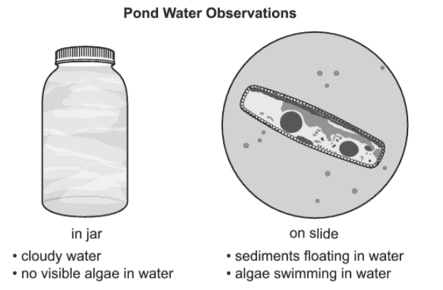
Cells and Microorganisms Review
Quiz by Gabriana Simmons
Feel free to use or edit a copy
includes Teacher and Student dashboards
Measures 3 skills from
- edit the questions
- save a copy for later
- start a class game
- automatically assign follow-up activities based on students’ scores
- assign as homework
- share a link with colleagues
- print as a bubble sheet
- Q1
A student collects a sample of pond water in a jar to observe the microscopic algae that live in the water . The student then places a drop of the pond water on a microscope slide and observes it under a microscope . The drawings below show what the student observed in the jar and on the slide .Which claim is supported by evidence in the drawings?
The student observed microscopic algae only on the slide because all of the algae cells were removed from the pond water on the microscope slide.
The student observed microscopic algae only on the slide because the water in the jar was too cloudy to see the algae.
The student observed microscopic algae only on the slide because algae grow larger when placed on a microscope slide.
The student observed microscopic algae only on the slide because algae cells are too small to be seen without magnification by a microscope.
60sS5L3a - Q2
Marco's mother tells him that he should wash his hands often with soap and water. Marco knows that washing his hands can help prevent the spread of microorganisms.Why is it important not to spread microorganisms?
Microorganisms give people energy.
Microorganisms can cause people to get sick.
Microorganisms have a bad taste.
Microorganisms always make people healthy.
60sS5L4 - Q3
Which of the following is true about microorganisms and disease?
Microorganisms can cause disease only in humans.
All kinds of microorganisms can cause disease in humans.
All human diseases are caused by microorganisms.
Some diseases are caused by microorganisms, and some are not.
60sS5L4 - Q4
Harmful microorganisms often enter the body through the eyes, nose, or mouth. These microorganisms can
make skin stronger.
cause diseases.
make hair grow.
supply the lungs with air.
60sS5L4 - Q5
Tanya thinks that bacteria can be harmful to humans. She learned that E. coli is a bacteria that is found in the intestines of humans. She also learned that different strains of E. coli affect the intestines differently. Which effect of E. coli supports Tanya's claim that bacteria can be harmful to humans?
Some strains of E. coli produce vitamin K.
Some strains of E. coli increase digestion of food.
Some strains of E. coli damage the intestinal wall.
Some strains of E. coli increase absorption of nutrients.
60sS5L4 - Q6
Humans sometimes become infected with bacteria, fungi, or parasites. How do these organisms cause disease in the humans they infect?
They decrease the human's basic needs.
They interfere with the human's normal body functions.
They only affect the human's future offspring.
They increase in size until they are larger than the human.
60sS5L4 - Q7
The picture below shows what Rosa observed when she used a tool to look at a plant leaf. Which statement best describes the tool Rosa used and what she learned from the leaf
She used a hand lens and learned that plants are made of one cell.
She used a microscope and learned that plants are made of one cell.
She used a hand lens and learned that plants are made of many cells.
She used a microscope and learned that plants are made of many cells.
60sS5L3a - Q8
Which of these pictures most likely shows part of an object that has been magnified?
60sS5L3a - Q9
An amoeba is a living thing that is made up of only one cell. It is too small to see with just your eyes.What tool could be used to see an amoeba?
microscope
sunglasses
hammer
pencil
60s - Q10
All organisms are made up of one or more cells.Which tool is used to observe cells and the structures within?
a ruler
a graduated cylinder
a microscope
a telescope
60sS5L3a - Q11
Which part of a cell is the cell's control center?
cell membrane
nucleus
cell wall
cytoplasm
60sS5L3 - Q12
Which of the following gives a plant cell its strong structure and definite shape?
nucleus
cell membrane
cell wall
chloroplasts
60sS5L3 - Q13
The fluid substance that holds the organelles of the cell is called the _______.
cell wall
cell membrane
nucleus
cytoplasm
60sS5L3 - Q14
What function does the membrane perform in an animal cell?
provides a rigid shape to the cell
helps control transport of material into and out of the cell
contains the genetic material of the cell
captures sunlight to produce food
60sS5L3 - Q15
Plant cells are green, and animal cells are not. This is because plant cells contain _______, and animal cells do not.
cell membranes
more than one nucleus
chloroplasts
green cytoplasm
60sS5L3
